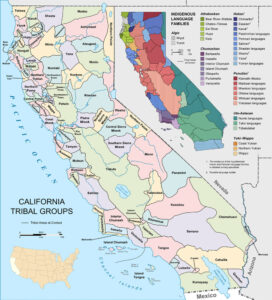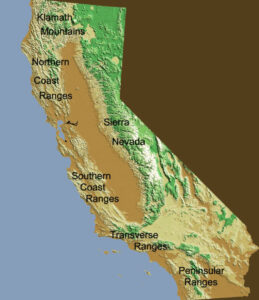The indigenous peoples of California were the inhabitants who previously lived or currently live within the current boundaries of the Golden State before and after the arrival of Europeans.
The earliest Californians were adventurous Asians who traveled across the Bering Straits to Alaska thousands of years ago when a warmer climate and a now-vanished land bridge made such travel easier. These men and women and their descendants settled in North and South America, spreading out to form the various nations and tribes the first European visitors called “Indians.” The mountain ranges of the Pacific Coast isolated these early settlers from the cultures that developed in neighboring Mexico and the western United States. Thus, the early population of California bore little physical resemblance to the Native Americans of the Great Plains and shared no ties of language or culture with these nations.
California’s rugged topography, marked by mountain ranges and deserts, made it difficult for her indigenous groups to travel great distances, and the region’s native peoples were even isolated from each other, tending to live in large family groups or clans with little political structure, unlike the larger tribes and nations to the east. As European settlement came late to California, her natives were also denied access to the newcomers’ horses, whose runaways fathered the wild herds that gave Great Plains tribes new mobility as early as the 16 century. Thus divided and isolated, the original Californians were a diverse population, separated by language into as many as 135 distinct dialects. Tribes included the Karok, Maidu, Cahuilleno, Mojave, Yokuts, Pomo, Paiute, and Modoc. On the other hand, the mountains that divided the groups made extensive warfare impractical, and the California tribes and clans enjoyed a comparatively peaceful life.
The region’s lack of rain during the growing season meant that agriculture was not a practical livelihood for early Californians. However, the gentle climate and rich soil enabled these groups to live by skillfully harvesting and processing wild nuts and berries and capturing the fish that crowded the streams. The acorn, leached of toxic acids and turned into meal, was a staple of the diet of most California native peoples. Indeed, the first English-speaking Europeans to encounter California Native Americans were so struck by their focus on gathering nuts from the ground and unearthing nutritious roots that they nicknamed them “Diggers,” and “Digger Indian” became a vague nickname for many of the groups.
An ample food supply, a temperate climate, and the absence of wars contributed to a large, healthy population. It has been estimated that when Europeans first came to California, the native population was probably close to 300,000, about 13% of indigenous peoples in North America.
Tribe Names |
Region |
Language Family |
Information/Status |
| Ahwahnechee | East-Central California | Live in the Yosemite Valley. Fighting for Federal Recognition. | |
| Acjachemem/Juaneño | Southern California | Uto-Aztecan language of Southern California. Closely related to Luiseno. | The Acjachemem people historically lived in present-day Orange, northern San Diego, southern Los Angeles, and western Riverside Counties of California. The Juaneño is state recognized and working on Federal recognition. |
| Antoniaño | Coastal Central California | Salinan Family | One of two divisions of Salinan, which is working on Federal recognition. |
| Atsugewi | Northeastern California | Palaihnihan Family | Many are enrolled in the Pit River Tribe, while others are members of the Susanville Indian Rancheria. |
| Awaswas | West-Central California | Ohlone/Costanoan | Some are members of the Amah Mutsun Tribe. |
| Bankalachi | On the west slopes of the Greenhorn Mountains | Tubatulabal | A band of Tubatulabal is seeking Federal Recognition. |
| Barbareño | Coastal Southern California | Chumash | A band of Chumash. |
| Cahuilla | Southern California | Cahuilla | There are several Federally Recognized bands. |
| Chalon | West-Central California | Ohlone/Costanoan | Currently, there are no Chalon organizations. |
| Chochenyo | West-Central California | Chochenyo | A division of the Ohlone/Costanoan. |
| Chumash | Coastal Southern California | Chumash | Only the Santa Ynez Chumash have received federal recognition. |
| Chilula | Northwestern California | Athapascan Family | Chilula descendants have since been incorporated into the Hupa. |
| Chimariko | Northwestern California | Chimariko | Extinct |
| Chukchansi, Foothill Yokuts | Central California | Yokuts | The Picayune Rancheria of the Chukchansi is federally recognized. |
| Coast Miwok | West-Central California | Miwok | The Federated Indians of Graton Rancheria, formerly the Federated Coast Miwok, is federally recognized. This tribe consists of people of Coast Miwok and Southern Pomo descent. |
| Coso | Southeastern California | Numic | The Coso are usually considered part of the Northern Paiute. |
| Cruzeño, Island Chumash | Coastal Southern California | Chumash | Part of the Chumash. |
| Cupeño | Southern California | Luiseno-Cahuilla branch of Shoshonean | Absorbed into other tribes. |
| Cuyamaca Complex | Southern California | Kumeyaay, Diegueño, Kumia | Late Holocene Precolumbian culture. |
| Eel River Athapaskan Peoples | Northwestern California | Dialects of the Wailaki language belonging to the Pacific Coast Athabaskan group of the Athapaskan language family. | They were essentially annihilated during the Bald Hills War in the 1860s. Some descendants are members of Round Valley Indian Tribes. |
| Esselen | West-Central California | A distinct language. | Not Federally Recognized. |
| Huchnom | Northwestern California | Yuki | A band of Yuki. |
| Hupa | Northwestern California | Hupa | Most of the tribe is enrolled in the federally recognized Hoopa Valley Tribe. |
| Inezeño, Ineseño | Coastal Southern California | Chumash | |
| Ipai | Southwestern California | Kumeyaay, Diegueño, Kumia | |
| Jamul | Southwestern California | Kumeyaay, Diegueño, Kumia | |
| Juaneño, Acjachemem | Southwestern California | ||
| Karkin | West-Central California | Ohlone/Costanoan | |
| Karok | Northwestern California | ||
| Kato, Cahto | Northwestern California | ||
| Kawaiisu | South-Central California | ||
| Kitanemuk | South-Central California | ||
| Kizh Nation | Southern California | ||
| Konkow | North-Central California | Maidu | The KonKow Valley Band of Maidu Indians is not federally recognized. |
| Konomihu | Northwestern California | Shasta | |
| Kucadikadi | East-Central California | ||
| Kumeyaay, Diegueño, Kumia | Southern California | ||
| La Jolla Complex | Southern California | Extinct, 6050-1000 BCE | |
| Lake Miwok | West-Central California | Miwok | |
| Lassik | Northwestern California | Eel River Athapaskan Peoples | |
| Luiseño | Southwestern California | ||
| Maidu | Northeastern California | Maidu | Several federally recognized bands. |
| Mattole, Bear River | Northwestern California | Eel River Athapaskan Peoples | |
| Mechoopda | Northern California | Maidu | The Mechoopda Indian Tribe of Chico Rancheria is federally recognized. |
| Migueleño | Coastal Central California | Salinan Family | |
| Miwok, Me-wuk | Central California | Miwok | Comprised of numerous bands, many of which are federally recognized. |
| Mojave | Southeastern California | ||
| Monache, Western Mono | Central California | ||
| Mono | East-Central California | ||
| Mutsun | West-Central California | Ohlone/Costanoan | |
| Muwekma | West-Central California | Ohlone/Costanoan | |
| Nisenan, Southern Maidu | East-Central California | Maidu | The Nisenan of Nevada City Rancheria is not federally recognized. |
| Nomlaki | Northwestern California | ||
| Nongatl | Northwestern California | Eel River Athapaskan Peoples | |
| Northern Valley Yokuts | Central California | Yokuts Family | |
| Obispeño, Northern Chumash | Coastal Southern California | Chumash | |
| Ohlone/Costanoan | West-Central California | Ohlone/Costanoan | |
| Okwanuchu | Northwestern California | Shasta | |
| Palagewan | On the Kern River above its confluence with the South Fork of the Kern River. | Tubatulabal | |
| Patayan | Southern California | ||
| Patwin | Central California | ||
| Pauma Complex | Southern California | Extinct – ca. 6050-1000 BCE | |
| Pit River Tribe,, Achomawi, Achumawi, | Northeastern California | Hokan Family | Federally Recognized. |
| Pomo | Northwestern and West-Central California | ||
| Purisimeño | Coastal Southern California | Chumash | |
| Ramaytush | West-Central California | Ohlone/Costanoan | |
| Rumsen | West-Central California | Ohlone/Costanoan | |
| Saklan | West-Central CaliforniaMiwok | ||
| Salinan | Coastal Central California | Salinan Family | |
| Serrano | Southern California | ||
| Shasta | Northwestern California | ||
| Sinkyone | Northwestern California | Eel River Athapaskan Peoples | |
| Suisun, Southern Patwin | Central California | Patwin | |
| Tachi, Southern Valley Yokuts | South-Central California | Yokuts Family | |
| Tamyen | West-Central California | Ohlone/Costanoan | |
| Tatavium/Aliklik | Southern California | ||
| Timbisha | Southeastern California | ||
| Tipai | Southwestern California and Northwestern Mexico | Kumeyaay, Diegueño, Kumia | |
| Tolowa | Northwestern California | ||
| Tsnungwe | Northwestern California | Hupa | |
| Tubatulabal | South-Central California | Tubatulabal | |
| Valley and Sierra Miwok | East-Central California | Miwok | |
| Ventureño | Coastal Southern California | Chumash | |
| Wailaki, Wai-lakki | Northwestern California | Eel River Athapaskan Peoples | |
| Wappo | North-Central California | ||
| Washoe | Northeastern California | ||
| Whilkut | Northwestern California | ||
| Wintu | Northwestern California | Wintu | |
| Wiyot | Northwestern California | Federally recognized. | |
| Yahi | North-Central California | Yana | |
| Yana | North-Central California | Yana | |
| Yelamu | West-Central California | Ohlone/Costanoan | |
| Yokuts | Central and Southern California | ||
| Yurok | Northwestern California | Federally recognized. |
©Kathy Alexander/Legends of America, updated March 2023.
Also See:
Native Americans – The First Owners of America
Native American Photo Galleries
Sources:
California Frontier Project
Heizer, Robert F. and Sturtevant, William C.; Handbook of North American Indians, Volume 8: California. Washington, DC: Smithsonian Institution, 1878.
Library of Congress
Wikipedia



